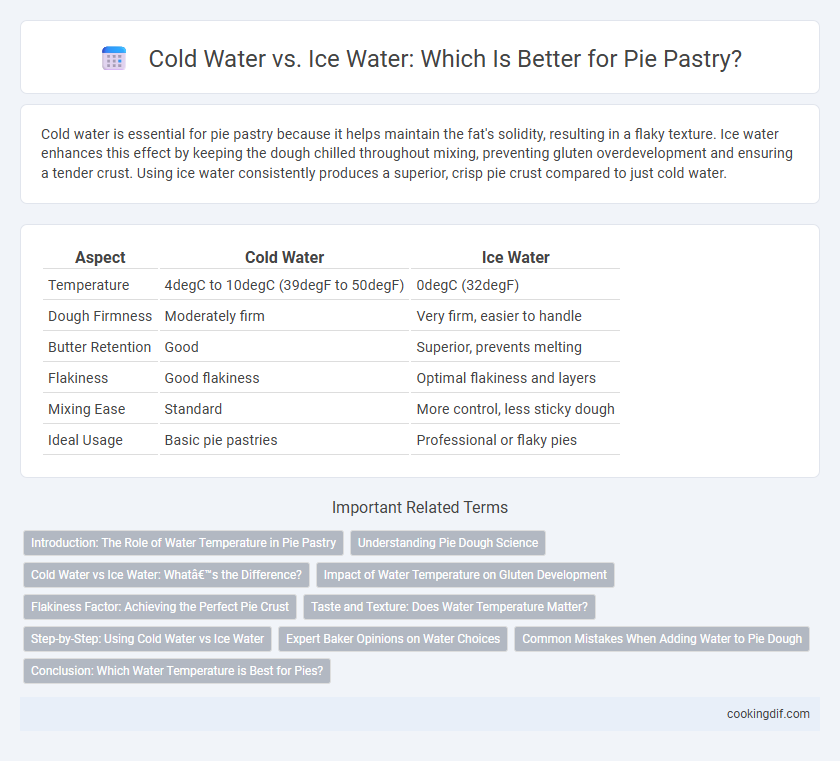Cold water is essential for pie pastry because it helps maintain the fat's solidity, resulting in a flaky texture. Ice water enhances this effect by keeping the dough chilled throughout mixing, preventing gluten overdevelopment and ensuring a tender crust. Using ice water consistently produces a superior, crisp pie crust compared to just cold water.
Table of Comparison
| Aspect | Cold Water | Ice Water |
|---|---|---|
| Temperature | 4degC to 10degC (39degF to 50degF) | 0degC (32degF) |
| Dough Firmness | Moderately firm | Very firm, easier to handle |
| Butter Retention | Good | Superior, prevents melting |
| Flakiness | Good flakiness | Optimal flakiness and layers |
| Mixing Ease | Standard | More control, less sticky dough |
| Ideal Usage | Basic pie pastries | Professional or flaky pies |
Introduction: The Role of Water Temperature in Pie Pastry
Cold water is essential in pie pastry preparation because it helps maintain the solid state of butter or shortening, resulting in a flakier crust. Using ice water further lowers the dough temperature, preventing the fats from melting too quickly and ensuring a tender texture. The precise control of water temperature directly influences gluten development and moisture balance, which are critical for optimal pie crust quality.
Understanding Pie Dough Science
Cold water maintains the optimal temperature for gluten development in pie pastry, ensuring a tender crust by preventing excessive protein bonding. Ice water further slows down the mixing process, minimizing gluten formation and keeping the fat solid, which creates flakier layers during baking. Using the right water temperature is crucial for achieving the ideal balance between elasticity and flakiness in pie dough science.
Cold Water vs Ice Water: What’s the Difference?
Cold water and ice water serve different purposes in pie pastry preparation, primarily affecting dough texture and gluten development. Ice water, kept at just above freezing, helps keep the fat solid, resulting in a flakier crust as the fat melts slowly during baking, creating steam pockets. Cold water, typically around refrigerator temperature, is easier to handle but may produce a slightly less flaky crust due to earlier melting of fats, impacting the pastry's tenderness and layering.
Impact of Water Temperature on Gluten Development
Cold water slows gluten development in pie pastry, resulting in a tender, flaky crust by minimizing gluten formation. Ice water further restrains gluten strands from over-forming, enhancing pastry flakiness and preventing toughness. The optimal pie crust texture depends on maintaining low water temperature to control gluten network strength.
Flakiness Factor: Achieving the Perfect Pie Crust
Using ice water instead of cold water significantly enhances the flakiness factor in pie pastry by keeping the butter solid until baking, creating distinct layers in the crust. The colder temperature prevents premature butter melting, allowing steam to form pockets during baking, which results in a tender, flaky texture. For the perfect pie crust, consistently incorporating ice water ensures maximum flakiness and structural integrity.
Taste and Texture: Does Water Temperature Matter?
Using cold water instead of ice water in pie pastry can slightly affect the dough's texture and taste by influencing gluten development; cold water helps maintain a tender, flaky crust while ice water slows gluten formation even more, resulting in an exceptionally delicate texture. The lower temperature of ice water keeps butter bits more intact during mixing, enhancing flakiness and preventing a tough pastry. Flavor differences are minimal, but the chilling effect of ice water contributes to a lighter mouthfeel and improved overall pie crust quality.
Step-by-Step: Using Cold Water vs Ice Water
Using ice water for pie pastry chills the dough more effectively, which prevents gluten development and results in a flakier crust. Step-by-step, combine flour and fat, then add ice water gradually while mixing gently to maintain dough temperature. Cold water can be used but may not keep the dough as cold, potentially leading to tougher pastry texture.
Expert Baker Opinions on Water Choices
Expert bakers emphasize that cold water, typically between 38degF and 50degF, is ideal for pie pastry because it helps maintain the fat's solidity, resulting in a flaky crust. Ice water, often around 32degF, can be too cold and slow the dough's hydration, making it harder to mix evenly. Many professionals recommend cold water over ice water to achieve the perfect texture and consistency in pie dough.
Common Mistakes When Adding Water to Pie Dough
Using ice water instead of just cold water is essential for making flaky pie pastry because it keeps the fat from melting prematurely, preventing tough dough. A common mistake is adding water too quickly or in excess, which leads to sticky dough and difficulty in rolling out. Precise measurement and gradual mixing of ice water strengthen gluten control, resulting in tender, crispy pie crusts.
Conclusion: Which Water Temperature is Best for Pies?
Cold water is optimal for pie pastry as it effectively keeps the fat solid, ensuring a flaky, tender texture. Ice water can also be used but may make dough handling slightly more challenging due to its temperature, potentially leading to overworking the dough. Maintaining the dough's temperature with cold water strikes the best balance for achieving a crisp, buttery crust.
Cold water vs Ice water for pie pastry Infographic

 cookingdif.com
cookingdif.com